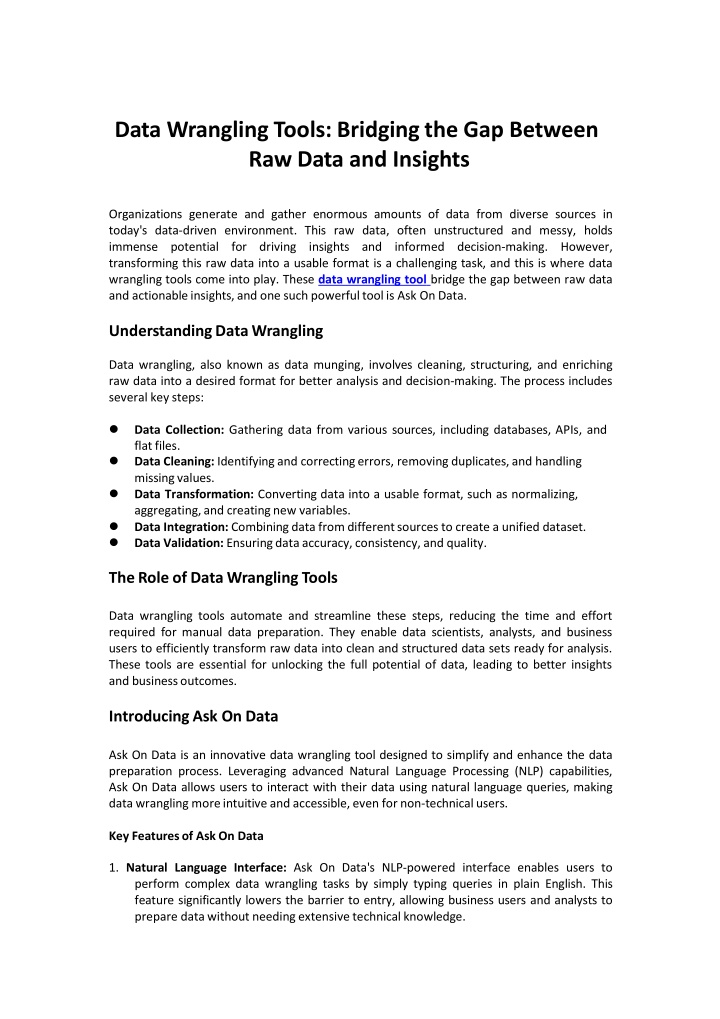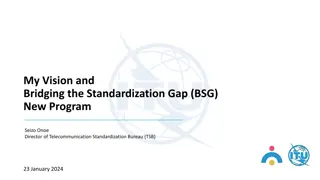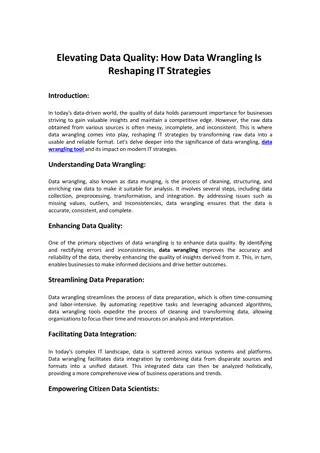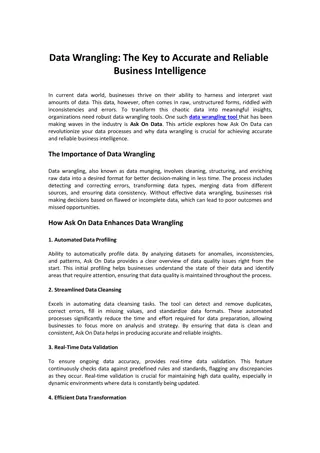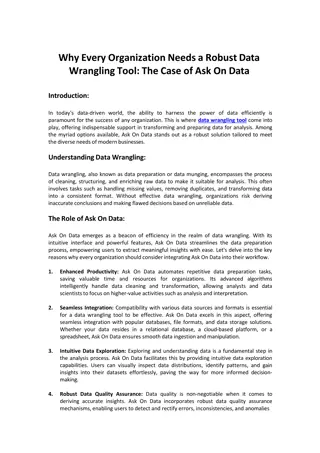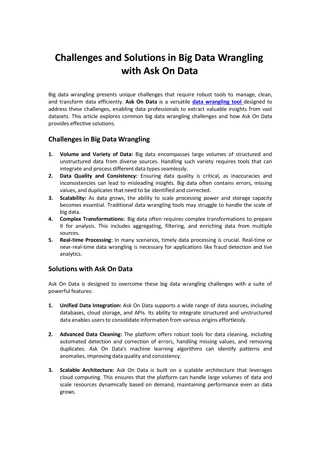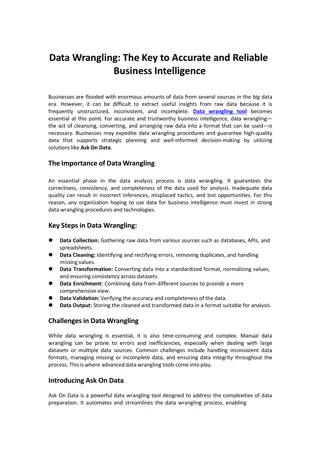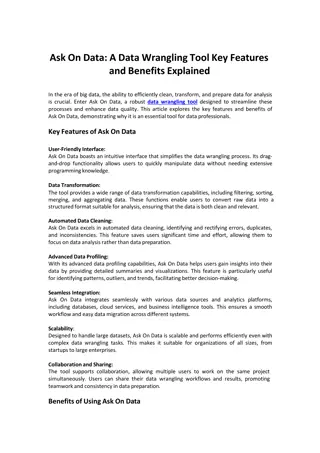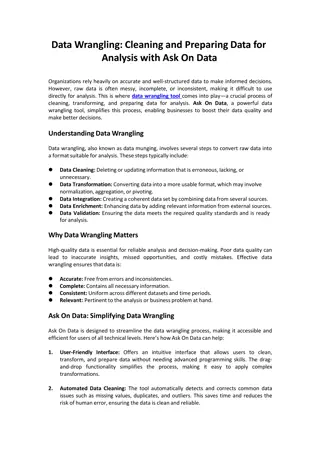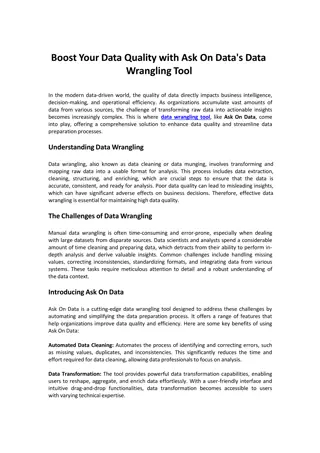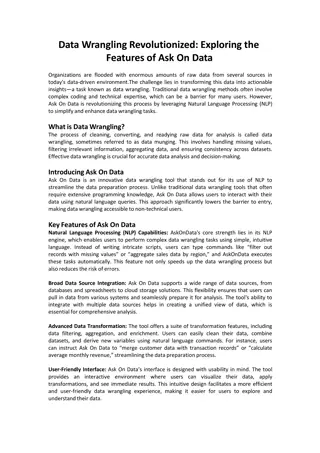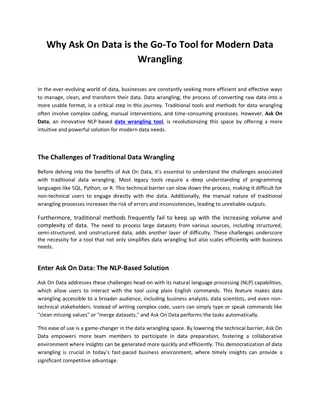Bridging the Gap Between Raw Data and Insights with Data Wrangling Tool
Organizations generate and gather enormous amounts of data from diverse sources in today's data-driven environment. This raw data, often unstructured and messy, holds immense potential for driving insights and informed decision-making. However, transforming this raw data into a usable format is a challenging task, and this is where data wrangling tools come into play. These data wrangling tool bridge the gap between raw data and actionable insights, and one such powerful tool is Ask On Data.
Download Presentation

Please find below an Image/Link to download the presentation.
The content on the website is provided AS IS for your information and personal use only. It may not be sold, licensed, or shared on other websites without obtaining consent from the author.If you encounter any issues during the download, it is possible that the publisher has removed the file from their server.
You are allowed to download the files provided on this website for personal or commercial use, subject to the condition that they are used lawfully. All files are the property of their respective owners.
The content on the website is provided AS IS for your information and personal use only. It may not be sold, licensed, or shared on other websites without obtaining consent from the author.
E N D
Presentation Transcript
Data WranglingTools: Bridgingthe Gap Between Raw Data and Insights Organizations generate and gather enormous amounts of data from diverse sources in today's data-driven environment. This raw data, often unstructured and messy, holds immense potential for driving insights transforming this raw data into a usable format is a challenging task, and this is where data wrangling tools come into play. These data wrangling tool bridge the gap between raw data and actionableinsights,and onesuchpowerfultoolis Ask OnData. and informed decision-making. However, UnderstandingDataWrangling Data wrangling, also known as data munging, involves cleaning, structuring, and enriching raw data into a desired format for better analysis and decision-making. The process includes several key steps: Data Collection: Gathering data from various sources, including databases, APIs, and flatfiles. Data Cleaning:Identifyingand correctingerrors, removingduplicates,and handling missingvalues. Data Transformation: Converting data into a usable format, such as normalizing, aggregating,and creating new variables. Data Integration:Combiningdata fromdifferentsources to create a unified dataset. Data Validation:Ensuring dataaccuracy,consistency, and quality. TheRoleofData WranglingTools Data wrangling tools automate and streamline these steps, reducing the time and effort required for manual data preparation. They enable data scientists, analysts, and business users to efficiently transform raw data into clean and structured data sets ready for analysis. These tools are essential for unlocking the full potential of data, leading to better insights and businessoutcomes. IntroducingAsk OnData Ask On Data is an innovative data wrangling tool designed to simplify and enhance the data preparation process. Leveraging advanced Natural Language Processing (NLP) capabilities, Ask On Data allows users to interact with their data using natural language queries, making datawrangling moreintuitiveand accessible,even fornon-technicalusers. Key Featuresof AskOn Data 1. Natural Language Interface: Ask On Data's NLP-powered interface enables users to perform complex data wrangling tasks by simply typing queries in plain English. This feature significantly lowers the barrier to entry, allowing business users and analysts to prepare datawithoutneedingextensivetechnicalknowledge.
2. Automated Data Cleaning: The tool automatically detects and corrects common data quality issues such as missing values, duplicates, and formatting errors. This ensures thattheresultingdatais accurate and reliable. 3. Data Transformation and Integration: Ask On Data provides robust transformation capabilities, allowing users to reshape and enrich their data. It supports operations like aggregation,normalization,and merging datasets frommultiplesources. 4. Data Validation and Quality Checks: Ensuring data quality is a critical aspect of data wrangling. Ask On Data includes built-in validation features that check for data consistency, accuracy, and completeness, helping users maintain high data quality standards. 5. Scalability and Performance: Designed to handle large volumes of data, Ask On Data ensures efficient processing and transformation, making it suitable for organizations of all sizes. 6. User-Friendly Interface: The intuitive interface of Ask On Data simplifies the data wrangling process. Users can easily navigate through different functionalities, making thetoolaccessibletobothtechnicaland non-technicalusers. Benefits ofUsing Ask On Data Increased Productivity: By automating tedious data preparation tasks, Ask On Data frees up valuable time for data scientists and analysts, allowing them to focus on derivinginsightsand driving strategicdecisions. Enhanced Data Quality: With its robust data cleaning and validation features, Ask On Dataensures thatthedatausedfor analysisis accurate,consistent,and reliable. Reduced Learning Curve: The natural language interface makes it easy for non-technical users to perform data wrangling tasks, democratizing data access and fostering a data- driven culturewithintheorganization. Improved Decision-Making: Clean, structured, and high-quality data is the foundation of accurate analysis and insights. Ask On Data helps organizations make data-driven decisionsthatlead tobetterbusinessoutcomes. Conclusion Data wrangling is a critical step in the data analytics process, transforming raw data into a format that can drive meaningful insights. Tools like Ask On Data bridge the gap between raw data and actionable insights by simplifying and automating the data preparation process. With its advanced NLP capabilities, automated data cleaning, robust transformation features, and user-friendly interface, Ask On Data empowers organizations to unlock the full potential of their data, enhancing productivity, data quality, and decision-making. As the volume and complexity of data continue to grow, tools like Ask On Data will play an increasingly vital role in helping businessesharnessthepowerof their data.
